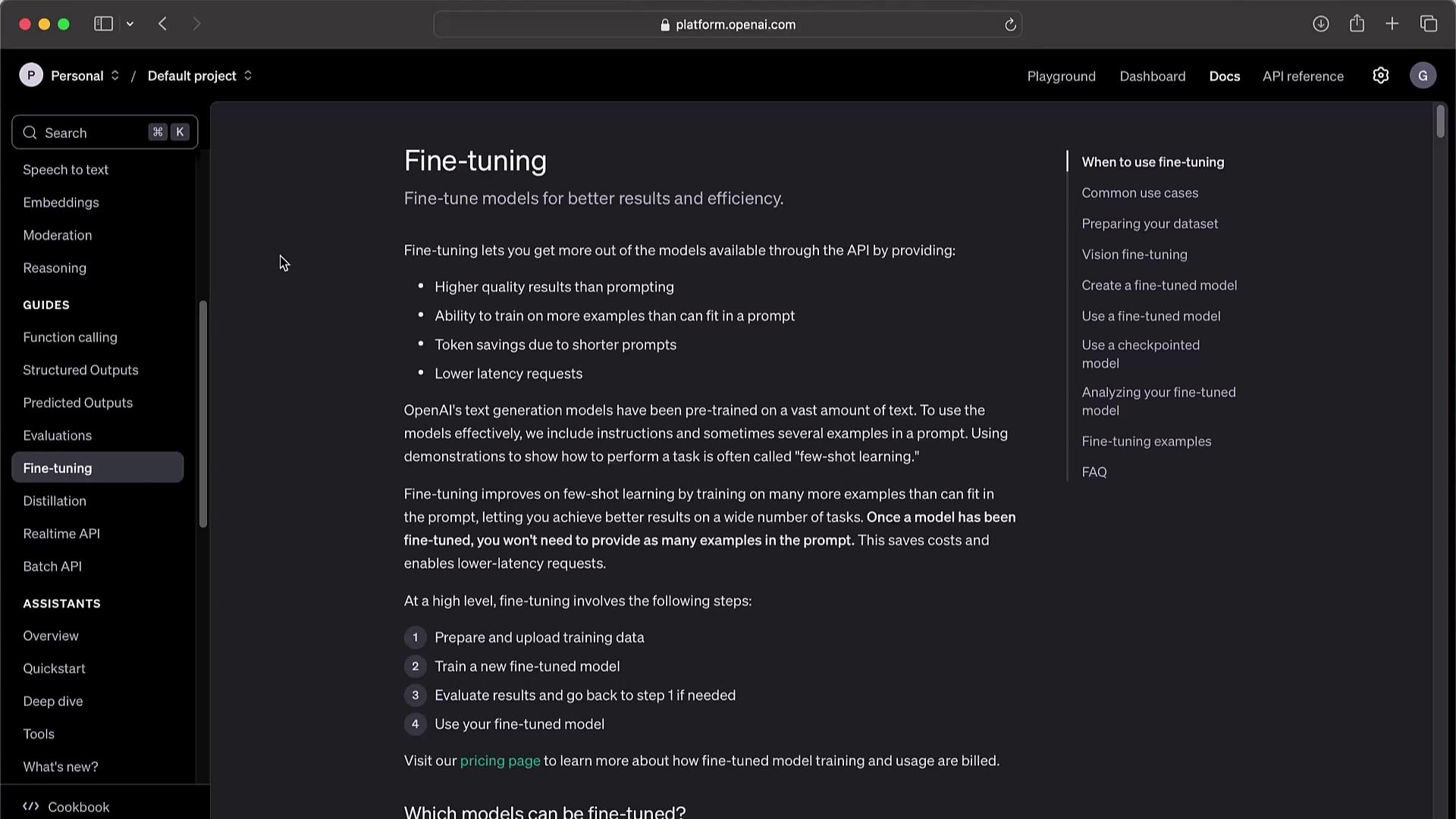Introduction to OpenAI
Vision
Fine Tuning
OpenAI fine-tuning lets you customize base models to your domain, improve response quality, and optimize for latency. In this guide, we'll walk through preparing data, launching jobs, monitoring progress, and deploying your fine-tuned model.

High-level workflow:
- Prepare and upload training data.
- Create a fine-tuning job.
- Evaluate the fine-tuned model.
- Deploy your custom model in production.
1. Preparing Training Data
High-quality JSONL data is critical for reliable GPT fine-tuning.
1.1 Text-Only Tasks
Each JSONL line contains a prompt and a completion. Example:
{"prompt":"Paris, as if everyone doesn't know that already.","completion":""}
{"prompt":"Oh, just some guy named William Shakespeare. Ever heard of him?","completion":""}
{"prompt":"Around 384,400 kilometers. Give or take a few, like that really matters.","completion":""}
Note
Ensure each completion begins with a space or newline if you want the model to include that prefix.
1.2 Vision or Chat Tasks
For visual or chat-based fine-tuning, wrap exchanges in a messages array. Example—image classification:
{
"messages": [
{"role":"system","content":"You are an assistant that identifies uncategorized images."},
{"role":"user","content":"What is this cheese?"},
{
"role":"user",
"content":[
{
"type":"image_url",
"image_url":{"url":"https://upload.wikimedia.org/wikipedia/commons/3/36/Danbo.jpg"}
}
]
},
{"role":"assistant","content":"Danbo"}
]
}
2. Uploading Data & Creating a Fine-Tuning Job
First, upload your JSONL as a file resource:
from openai import OpenAI
client = OpenAI()
file = client.files.create(
file=open("training-data.jsonl","rb"),
purpose="fine-tune"
)
Then launch the fine-tune job:
client.fine_tuning.jobs.create(
training_file=file.id,
model="gpt-4o-mini-2024-07-18"
)
3. Managing Fine-Tuning Jobs
Quick reference for common operations:
| Action | API Method |
|---|---|
| List jobs | client.fine_tuning.jobs.list(limit=10) |
| Retrieve job status | client.fine_tuning.jobs.retrieve("ftjob-abc123") |
| Cancel a job | client.fine_tuning.jobs.cancel("ftjob-abc123") |
| List job events | client.fine_tuning.jobs.list_events(job_id, limit=10) |
| Delete a fine-tuned model<sup>1</sup> | client.models.delete("ft:gpt-3.5-turbo:...") |
<sup>1</sup> You must be the organization owner to delete a model.
4. Fine-Tuning Examples
4.1 Style & Tone: Sarcastic “Marv” Chatbot
Upload and start a job for a witty assistant:
file = client.files.create(file=open("marv.jsonl","rb"), purpose="fine-tune")
client.fine_tuning.jobs.create(training_file=file.id, model="gpt-4o-mini-2024-07-18")
4.2 Structured JSON Outputs
For tasks requiring strict JSON responses (e.g., sports stats):
file = client.files.create(file=open("sports-context.jsonl","rb"), purpose="fine-tune")
client.fine_tuning.jobs.create(training_file=file.id, model="gpt-4o-mini-2024-07-18")
5. Function-Calling Integration
Fine-tuning can teach the model to invoke your functions. Example payload:
{
"messages":[
{"role":"user","content":"What is the weather in San Francisco?"},
{"role":"assistant","function_call":{"name":"get_current_weather","arguments":"{\"location\":\"San Francisco, USA\"}"}},
{"role":"function","name":"get_current_weather","content":"{\"temperature\":21,\"unit\":\"celsius\"}"},
{"role":"assistant","content":"It is 21 degrees celsius in San Francisco."}
],
"functions":[
{
"name":"get_current_weather",
"description":"Get the current weather.",
"parameters":{"type":"object","properties":{"location":{"type":"string"}},"required":["location"]}
}
]
}
6. Advanced Options & Monitoring
Integrate with Weights & Biases, include validation sets, and track metrics:
curl -X POST https://api.openai.com/v1/fine_tuning/jobs \
-H "Content-Type: application/json" \
-H "Authorization: Bearer $OPENAI_API_KEY" \
-d '{
"model":"gpt-4o-mini-2024-07-18",
"training_file":"file-ABC123",
"validation_file":"file-DEF456",
"integrations":[{"type":"wandb","wandb":{"project":"my-project","tags":["lineage","version1"]}}]
}'
7. Best Practices & Considerations
- Start with representative, high-quality data.
- Monitor for biases, guardrails, and compliance in regulated industries.
- Track token usage and costs to avoid surprises.
- Retrain periodically as requirements evolve.
Links and References
Watch Video
Watch video content